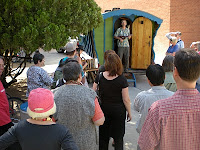

It had been 12 years since I'd opened my box of Japanese woodblock tools....Last week, I dusted the lid and peered inside. An immediate longing for the smell of carved wood came over me. Hmmmm, perhaps it is time again.
In 1987, on my first of two research trips to Japan, I studied
washi (traditional Japanese papermaking) and
moku hanga (Japanese woodblock printing). My focus in the following years, gradually leaned towards papermaking/paper sculpture, but the moku hanga techniques I'd learned were translated into mixed media drawings and large sumi paintings. By '98 I was painting with encaustics and embedding my papers/paintings into these molten wax paintings while always continuing to make washi works. Lately I've been monoprinting with encaustic but that's pretty painterly.
I have never forgotten that my roots began in printmaking....it's just felt like it's been put to the back burner. Does one ever completely lose the thinking pattern of a printmaker once ingrained?


I was so excited when I heard that
PaperWorks: The Sonoran Collective for Paper and Book Artists was hosting artist and master printer
Hiroki Morinoue from the big island of Hawaii to teach 2 days of moku hanga in Tucson. Morinoue would then travel to teach 2 days of experimental abstract watercolor at the Tubac Center for the Arts just 60 minutes south. Hey! Time to shake myself up, and spark a new creative flow!! I whittled out time in my schedule to take all four days.

In his artist statement, Hiroki Morinoue writes: "In all of my works, there is a compelling sense of place---of the shoreline, rocks, lava flows and skies of the Big Island. I have long been a patient observer of nature, in particular, of its rhythms, cycles, and patterns. My creativity is two-fold, one to express myself and the other to express and study different media most suited for the message I want to convey to the viewer."
Morinoue's work speaks to me through color, his personal iconography and references to nature.
Watching Morinoue go through a step by step demo of the very special Japanese techniques of woodblock printing with water based inks (in his case, straight from the tube watercolor paint slightly diluted, and blended with rice paste on the block) was like taking a drink of water after a long drought.
There are a few steps missing here to keep it relatively short, but it gives an idea:
Morinoue printed 9 colors on this demo piece, some multiple times to deepen the color and/or add a gradation.But when he started printing from varied blocks in a more intuitive manner creating woodblock printed monoprints, I was enthralled. Although Morinoue demoed carving and registration, our hands on focus was with trying to control the printing. We had access to a slew of pre-carved blocks. He explained that the light source
is the
paper, and to keep in mind that with each printing, we were subtracting light...
The idea of printing freely from numerous blocks, overlapping colors and shapes to create unique images was truly an
ah-ha moment for me. I totally appreciated the freedom and spontaneity of this manner of printing.
I am sure that other printmakers might have a different feeling, but my training and subsequent approach to printmaking, not only in Japan but also during the 14 years prior as well, was very controlled and preplanned....and this was precisely why I turned towards mixing media that would allow for unrehearsed, more spontaneous creation so to speak. I wanted the work to lead me sometimes, to have a conversation with it. Does that make sense?
At the end of the two days, our trimmed prints were pinned into a grid, truly a visual delight. We were asked to trade cropped images and reconfigure them into a new composition. A wonderful exercise and energetic way to end the workshop. Morinoue was adept at critique and offered pertinent suggestions and thoughts. He told me, "You should really consider being a printmaker!" I guess one just can't fully lose the mindset. And yes, I am one. Remember that, Nash. I'm pulling the pot from the back to the front burner~


The watercolor course in Tubac was just superb as well: totally fun (especially sharing the adventure with my friend Mabel), and I certainly learned a great deal, particularly about Morinoue's approach to color. As the painting techniques paralleled my own practice with sumi and watercolor painting, it didn't have quite the impact that holding a baren again had, but nonetheless it was exciting, fresh and still felt new. Perhaps at some level, I had mourned just a bit letting moku hanga go (after longing to go to Japan since I had been seven!...I had been having major issues with Tucson's total lack of humidity and Hiroki gave me some pertinent suggestions on what to do.) I had known it would reappear in my creative work, I just didn't know when.
I have, of late, been integrating handmade paper and cast paper with encaustic...oh, but now I can see doing mokuhanga on my own papers, and dipping them or enhancing them with encaustic monoprinting...for stand alone works or incorporated into artist books. Or carving the wood on which I paint encaustic...hmmmmmmmm.
Ah, that creative flow! So excited to have solid stretches of time before me as we head into the summer.
Throughout the workshops, his wife, artist Setsuko Morinoue was a hard working assistant and we appreciated her help too.
Thank you Hiroki and Setsuko Morinoue!





























































